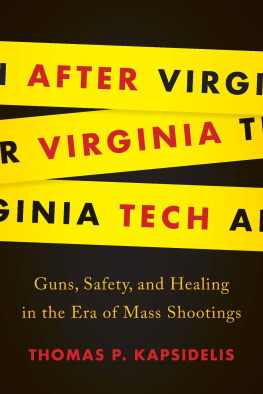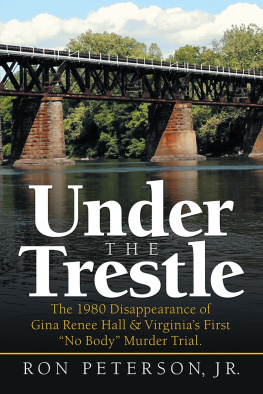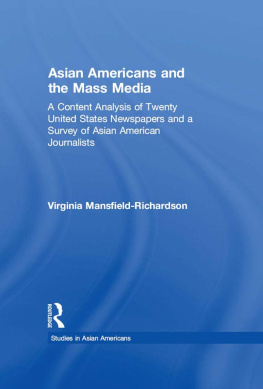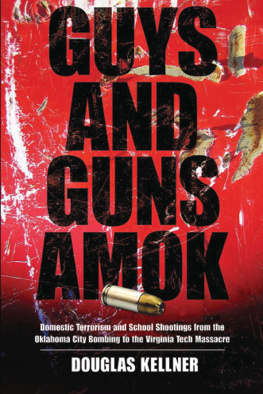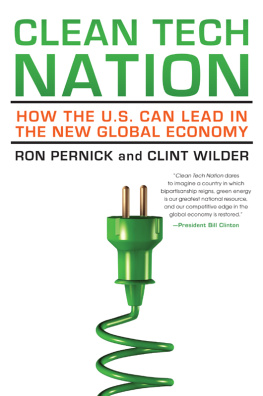University of Virginia Press
2019 by the Rector and Visitors of the University of Virginia
All rights reserved
Printed in the United States of America on acid-free paper
First published 2019
9 8 7 6 5 4 3 2 1
Library of Congress Cataloging-in-Publication Data
Names: Kapsidelis, Thomas P., 1956 author.
Title: After Virginia Tech : guns, safety, and healing in the era of mass shootings / Thomas P. Kapsidelis.
Description: Charlottesville : University of Virginia Press, 2019. | Includes bibliographical references and index.
Identifiers: LCCN 2018044531 | ISBN 9780813942223 (cloth : alk. paper) | ISBN 9780813942230 (ebook)
Subjects: LCSH: Virginia Tech Shootings, Blacksburg, Va., 2007. | Mass shootingsUnited States. | School shootingsUnited States. | Gun controlUnited States. | Victims of violent crimesUnited States. | Mental health servicesUnited States.
Classification: LCC HV 6534. B 53 K 37 2019 | DDC 362.8809755/785dc23
LC record available at https://lccn.loc.gov/2018044531
The wind blew so fiercely when I stopped for gas on the way to Virginia Tech that I had to push hard against the drivers-side door to slip out before it slammed behind me. An unseasonable snowfall had deepened the chill of April 16, 2007. When I went inside to pay, some innocuous joking between a customer and the clerk angered me at once. Didnt they know something awful had happened that morning? I was about halfway on a two-hundred-mile trip to Blacksburg, Virginia, for what I already knew was a mass shooting worse than Columbine.
I had been off duty that Monday morning from my job as weekend editor for the Richmond Times-Dispatch and had given my wife a ride to work as I followed the early reports of two students fatally shot in a dormitory. The first broadcast accounts hinted at something unresolved, that the situation could be worse than initially suspected. I pulled over on a neighborhood street and called my brother, the father of a Tech graduate, and learned the word was out, if not confirmed: There could be many more dead on campus. I circled back downtown to the newsroom to pitch in as needed. Before long, we received confirmation that the death toll could be unprecedented, and a supervisor nervously told me to go to Blacksburg to organize and edit the newspapers coverage.
I sped home to pack a bag and set out for Tech, driving as fast as I could stand. On the way, my cell phone rang constantly with either word from the desk that more staff members were on their way or from reporters asking who was doing what, where they should be, and what else did I know. The reporters told me that as fast as they were driving south on Interstate 81, they were passed by ambulances and state police as if standing still.
As I neared Blacksburg, I searched for a focus on the job ahead and how it would eclipse what I had experienced in thirty years as a journalist. I had been in charge of the coverage of the Maryland-to-Virginia sniper shootings, heavily involved in the post-9/11 reporting at our newspaper, and generally at the front line of nearly every major news event in Virginia during the previous two decades. But I had never reported or edited stories about a mass casualty or loss of life that would be felt so far beyond our borders. I thought about my college-age children and recalled how my wifes cousin, an Associated Press foreign correspondent, had done his job in war zones over extended periods of trauma. This story would need to be told with a clear head, and if journalists could do anything for the families, it would be to make sure that the complete facts were known.
With the first evenings deadlines approaching, I also considered what was ahead, as the story would continue over days, weeks, and months. Thirty-two students and professors had been killedit was the nations worst contemporary mass shooting at the time. The president would visit. The governor, a Democrat, could use the bully pulpit of his single term to make Virginia a leader on the gun-safety issues with which it had struggled so much in its distant and more recent historythe state was long known for exporting guns used in crimes in the Northeast. I tried to imagine for a moment what this tragedy would mean. Could the Tech killings change how people think about gun violence in Virginia and, by extension, the rest of the nation?
In the years since, these are some of the questions Ive set out to answer. Not just regarding Virginia Tech, but how the problems there, unaddressed, continued in a path that has led the nation to grieve so many. The emotions were felt most rivetingly after twenty first-graders and six adults were killed at Sandy Hook Elementary School, and in the bitter sorrow that followed in shootings across the country, from Emanuel African Methodist Episcopal Church in Charleston, where nine were killed, to the Pulse nightclub in Orlando, and from Las Vegas to Sutherland Springs. The death toll at Tech was surpassed on June 12, 2016, when forty-nine people were killed at the nightclub. Senator Timothy M. Kaine, who was governor during the Tech shootings, visited Orlando during his vice-presidential campaign and later said he had wished that Blacksburg had been a turning point. On October 1, 2017, shots fired from the thirty-second floor of the Mandalay Bay Resort and Casino in Las Vegas killed fifty-eight at a country music concert. Just over a month later in Texas, twenty-six were fatally shot at the First Baptist Church of Sutherland Springs, Texas.
But it was another mass school shooting in early 2018 that focused the nations attention on gun violence in a way that had not been seen since Newtown. When fourteen students and three faculty members were killed at Marjory Stoneman Douglas High School in Parkland, Florida, the teens and their supporters took to the streets, lobbied in Tallahassee, and marched in Washington. President Donald Trump flip-flopped on his responsefirst seeming to rebuke the National Rifle Association in a meeting with members of Congress and then complimenting the powerful lobby after hosting its officials in the Oval Office the following evening. But in Florida, the legislature delivered a blow to the NRA with a package of gun-safety measures. The actions didnt go as far as some advocates would like, but in the Gunshine State, one of the nations friendliest to gun rights, it was a sea change. You made your voices heard, Governor Rick Scott said to Parkland survivors.
For the survivors of the Virginia Tech shootings, those were words theyd been struggling to hear.
On that cold April morning more than a decade ago in Blacksburg, Seung-Hui Cho, a Tech senior, was armed with guns he had purchased with the aid of a loophole in the law that kept him from being blocked through a background check. He shot his first two victims at about 7:15 a.m. at West Ambler Johnston Hall dormitory. He then returned to his dorm, where he changed out of his bloody clothes and prepared a package to mail to NBC News in New York and a bitter letter to Techs English Department. The parcel for the network included pictures of him with weapons, as well as writings and video clips with references to a massacre. Cho sent his package from the Blacksburg post office before going to Norris Hall, chaining shut the doors, and fatally shooting thirty students and faculty members with a 9mm Glock and a .22 caliber Walther pistol. As police closed in, Cho shot himself in the front of the French classroom while his victims lay dead and injured, their cell phones ringing with unanswered calls from family and friends. In addition to the slain, seventeen more were shot and injured. Ten jumped from second-floor windows to escape the onslaught. Untold more were physically uninjured but suffered emotional wounds that would last a lifetime.

